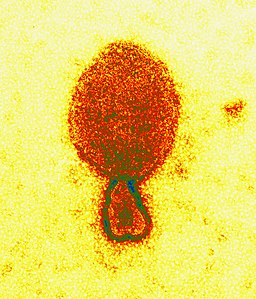User:Cbs8286

Classification
Viruses; Riboviria; Orthornavirae; Negarnaviricota; Haploviricotina; Monjiviricetes; Mononegavirales; Paramyxoviridae; Orthoparamyxovirinae; Henipavirus; unclassified Henipavirus
Species
|
NCBI: [1] |
Langya henipavirus
Description and Significance
Describe the appearance, habitat, etc. of the organism, and why you think it is important.
Genome Structure
At the point and time of writing this,November 15th 2022, Langya henipavirus’s genome is unmapped and unknown. However, we have mapped and studied several other henipaviruses such as the well known Nipah henipavirus and Hendrah henipavirus. So to better understand Langya henipavirus I have included information about the genus.
The Genus henipavirus genome is mononegaviral, Circular and around 18.2 kb in size, containing six protein production genes. Being a virus, it contains only a RNA strand and no chromosomes. The Henipavirus genus must follow a “rule of six”. Meaning that its genome must be a multiple of 6, if a mutation or incomplete genome synthesis occurs that deviates from this rule then they will be unable to replicate properly. (Kolakofsky et al. 1998).
Another interesting feature is its means of protein synthesis. Hepinaviruses uses co-transcriptional mRNA editing during transcription of the phosphoprotein gene to generate multiple protein synthesizing mRNAs from a singular gene. (Lo et Al. 2009).
Cell Structure, Metabolism and Life Cycle
Interesting features of cell structure; how it gains energy; what important molecules it produces.
Ecology and Pathogenesis
Langya Hepnipavirus was first found in north-eastern sections of China in the cities Shandong and Henan. (Lu 2022). Being a virus, LayV must parasitize its hosts to survive and reproduce, resulting in no meaningful contributions to its environment other than the roles fufilled as a pathogen.
Shrews have been determined to be the reservoir for this virus, with 27% out of 262 shrews tested showed detectable levels of LayV. Other animals that showed detectable levels but at much lower frequency include 5% out of 79 tested dogs and 2% out of 168 tested goats. (Murugesu 2022). Based on current research it likely spreads from animal to human through contact, although we are unsure if it is through contact of the shrew or some intermediate animal. There is no current evidence of human to human contact.(Shopnil et. al)
Symptoms of infection are as follows:
Broad symptoms recorded from infected patients include: Fever (54%), Fatigue (54%), Coughing(50%), Muscle aches/pains(46%), nauseousness(38%), headaches(35%) and vomiting(35%). (Murugesu 2022)
Some extreme symptoms recorded include: Leukopenia(54%) which is characterized by an “insufficient number of pathogen fighting white blood cells”, thrombocytopenia(35%) characterized by a lack of platelets in the blood stream, impaired liver function (35%) and impaired kidney function (8%). Although some symptoms can be life threatening without treatment, no known cases of death from the virus have been reported. (Murugesu 2022)
References
Akash, S., Rahman, M.M., Islam, M.R. and Sharma, R. (2022), Emerging global concern of Langya henipavirus: Pathogenicity, virulence, genomic features, and future perspectives. J Med Virol. https://doi.org/10.1002/jmv.28127
Kolakofsky D, Pelet T, Garcin D, Hausmann S, Curran J, Roux L. Paramyxovirus RNA synthesis and the requirement for hexamer genome length: the rule of six revisited. J Virol. 1998 Feb;72(2):891-9. doi: 10.1128/JVI.72.2.891-899.1998. PMID: 9444980; PMCID: PMC124558.
Lo MK, Harcourt BH, Mungall BA, Tamin A, Peeples ME, Bellini WJ, Rota PA. Determination of the henipavirus phosphoprotein gene mRNA editing frequencies and detection of the C, V and W proteins of Nipah virus in virus-infected cells. J Gen Virol. 2009 Feb;90(Pt 2):398-404. doi: 10.1099/vir.0.007294-0. PMID: 19141449.
Lu, Donna (10 August 2022). "Newly identified Langya virus tracked after China reports dozens of cases". The Guardian.
Murugesu, Jason Arunn (10 August 2022). "Langya virus: How serious is the new pathogen discovered in China?". New Scientist. Retrieved 15 November 2022.
Author
Page authored by Breeze Smith, student of Prof. Bradley Tolar at UNC Wilmington.
